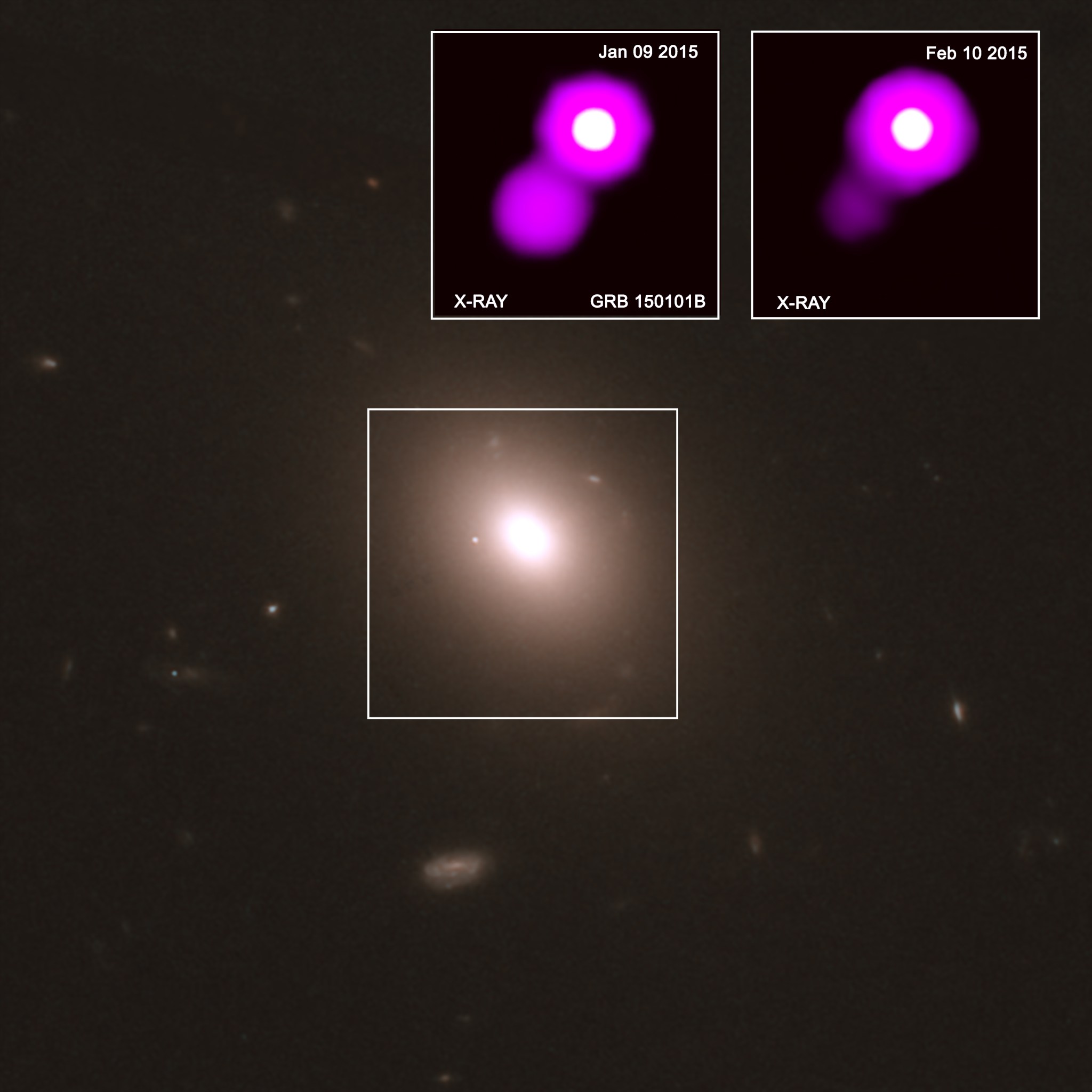About a year ago, astronomers excitedly reported the first detection of electromagnetic waves, or light, from a gravitational wave source. Now, a year later, researchers are announcing the existence of a cosmic relative to that historic event.
The discovery was made using data from telescopes including NASA’s Chandra X-ray Observatory, Fermi Gamma-ray Space Telescope, Neil Gehrels Swift Observatory, the NASA/ESA Hubble Space Telescope, and the Discovery Channel Telescope (DCT).
The object of the new study, called GRB150101B, was first reported as a gamma-ray burst detected by Fermi in January 2015. This detection and follow-up observations at other wavelengths show GRB150101B shares remarkable similarities to the neutron star merger and gravitational wave source discovered by Advanced Laser Interferometer Gravitational Wave Observatory (LIGO) and its European counterpart Virgo in 2017 known as GW170817. The latest study concludes that these two separate objects may, in fact, be related.
“It’s a big step to go from one detected object to two,” said Eleonora Troja, lead author of the study from NASA’s Goddard Space Flight Center in Greenbelt, Maryland, and the University of Maryland at College Park (UMCP). “Our discovery tells us that events like GW170817 and GRB150101B could represent a whole new class of erupting objects that turn on and off in X-rays and might actually be relatively common.”
Troja and her colleagues think both GRB150101B and GW170817 were most likely produced by the same type of event: the merger of two neutron stars, a catastrophic coalescence that generated a narrow jet, or beam, of high-energy particles. The jet produced a short, intense burst of gamma rays (known as a short GRB), a high-energy flash that can last only seconds. GW170817 proved that these events may also create ripples in space-time itself called gravitational waves.
The apparent match between GRB150101B and GW170817 is striking: both produced an unusually faint and short-lived gamma ray burst, and both were a source of bright, blue optical light lasting a few days, and X-ray emission lasted much longer. The host galaxies are also remarkably similar, based on Hubble and DCT observations. Both are bright elliptical galaxies with a population of stars a few billion years old and displaying no evidence for new stars forming.
“We have a case of cosmic look-alikes,” said co-author Geoffrey Ryan of UMCP. “They look the same, act the same and come from similar neighborhoods, so the simplest explanation is that they are from the same family of objects.”
In the cases of both GRB150101B and GW170817, the slow rise in the X-ray emission compared to most GRBs implies that the explosion was likely viewed “off-axis,” that is, with the jet not pointing directly towards the Earth. The discovery of GRB150101 represents only the second time astronomers have ever detected an off-axis short GRB.
While there are many commonalities between GRB150101B and GW170817, there are two very important differences. One is their location. GW170817 is about 130 million light years from Earth, while GRB150101B lies about 1.7 billion light years away. Even if Advanced LIGO had been operating in early 2015, it would very likely not have detected gravitational waves from GRB150101B because of its greater distance.
“The beauty of GW170817 is that it gave us a set of characteristics, kind of like genetic markers, to identify new family members of explosive objects at even greater distances than LIGO can currently reach,” said co-author Luigi Piro of National Institute for Astrophysics in Rome.
The optical emission from GB150101B is largely in the blue portion of the spectrum, providing an important clue that this event involved a so-called kilonova, as seen in GW170817. A kilonova is an extremely powerful explosion that not only releases a large amount energy, but may also produce important elements like gold, platinum, and uranium that other stellar explosions do not.
It is possible that a few mergers like the ones seen in GW170817 and GRB150101B had been detected as short GRBs before but had not been identified with other telescopes. Without detections at longer wavelengths like X-rays or optical light, GRB positions are not accurate enough to determine what galaxy they are located in.
In the case of GRB150101B, astronomers thought at first that the counterpart was an X-ray source detected by Swift in the center of the galaxy, likely from material falling into a supermassive black hole. However, follow-up observations with Chandra detected the true counterpart away from the center of the host galaxy.
The other important difference between GW170817 and GRB150101B is that without gravitational wave detection, the team does not know the masses of the two objects that merged. It is possible that the merger was between a black hole and a neutron star, rather than two neutron stars.
“We need more cases like GW170817 that combine gravitational wave and electromagnetic data to find an example between a neutron star and black hole. Such a detection would be the first of its kind,” said co-author Hendrik Van Eerten of the University of Bath in the United Kingdom. “Our results are encouraging for finding more mergers and making such a detection.”
A paper describing these results appears in the journal Nature Communications today and is available online. NASA’s Marshall Space Flight Center in Huntsville, Alabama, manages the Chandra program for NASA’s Science Mission Directorate in Washington. The Smithsonian Astrophysical Observatory in Cambridge, Massachusetts, controls Chandra’s science and flight operations.
Read more from NASA’s Chandra X-ray Observatory.
For more Chandra images, multimedia and related materials, visit:




























